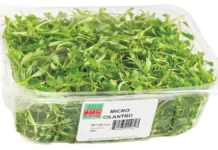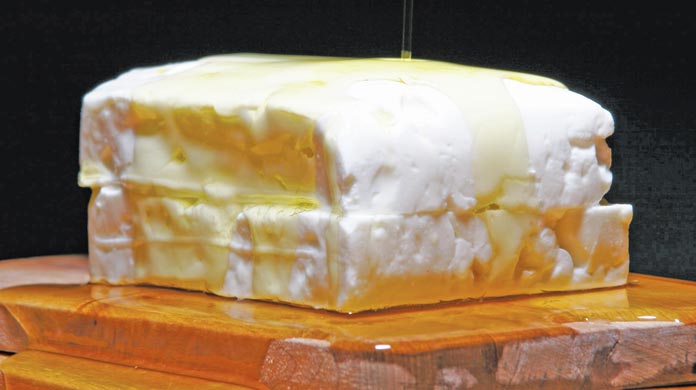
Greek Feta cheese is said to have been a food of the Gods.
Homer’s poems tell of how the Cyclops, Polyphemus, the son of Poseidon – the God of the Sea – made cheese some 3,000 years ago almost by accident after noticing that the milk he collected from sheep and stored in the ‘askos’ (bags made of animal skin) had ripened within days into a delectable, new form. Though this story is part of Greek mythology, the fact is – Feta has stood the test of time for thousands of years. This soft, creamy, tangy cheese was a key ingredient in the diet of ancient Greeks’ and today it remains a critical component of the healthy, modern, delicious Mediterranean diet too.
But not all Feta is created equal. Not by a long shot. As a proud Greek, I know good Greek Feta the moment I taste it and it won’t take long for you to do the same. Here’s what you need to know about Feta cheese, why it’s the best, how to ensure you’re getting the real deal – and why you should never, ever consider buying anything else.
What makes Feta cheese Greek?
Feta cheese is Greek. That’s not just something I’m claiming as a proud Greek; The European Commission actually declared it so in 2002 when it gave Greek Feta the Protected Designation of Origin or PDO. The PDO designation honors the fact that certain traditional food products come from specific places in the world and that they are created, prepared and produced in accordance with strict quality and safety guidelines.
In the case of Greek Feta, the PDO designation ensures that the cheese is not made from powdered milk or cow’s milk, and does not contain colorants, preservatives or antibiotics. These high standards guarantee a purity that you will taste in every delicious bite.
Where does Greek Feta come from?
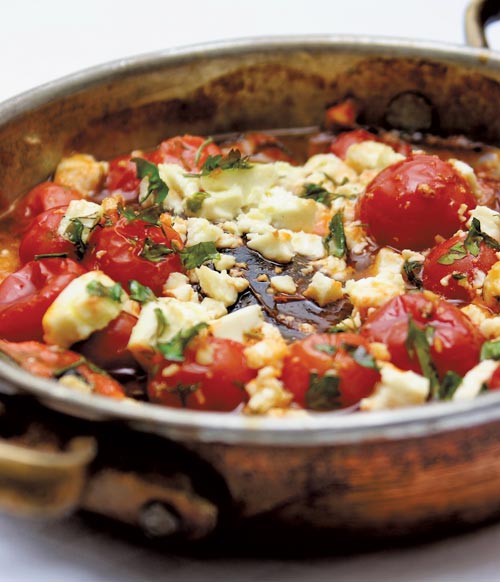 The PDO designation means a particular product comes from a specific geographical location in the world. Greek Feta comes from the milk of sheep and goats that graze freely in several different regions of Greece including Macedonia, Thrace, Epirus, Thessaly, Peloponnese, Mainland Greece, and Lesvos.
The PDO designation means a particular product comes from a specific geographical location in the world. Greek Feta comes from the milk of sheep and goats that graze freely in several different regions of Greece including Macedonia, Thrace, Epirus, Thessaly, Peloponnese, Mainland Greece, and Lesvos.
The milk is first pasteurized and then it goes through a traditional process of curding, straining and salting, before being placed in wooden barrels or metal tins to age in brine (a mixture of salt and water) for at least two months and sometimes up to a year. It is this aging process that allows Feta cheese to develop its unique character, flavor, and aroma – and this is how my mother taught my siblings and me how to make our family’s Feta growing up – only without the pasteurization.
Once you and your customers taste the real Greek Feta – much like other PDO products – Champagne from France or Parmigiano Reggiano from Italy – you’ll understand nothing else compares. You will notice subtle differences in Greek Feta depending on the region it comes from. That’s because there’s different flora (flowers and plants) that sheep and goats graze on which can affect both the taste and consistency of the Feta. I’ve traveled all over Greece and tried Feta in every region where it’s made. In Thessaly, for example, the grassy notes in the Feta are more pronounced, whereas in Macedonia, it is the essence of lemon you first experience. My favorite type of Feta is both creamy and tangy, and just dry enough that it crumbles beautifully – while being moist all at the same time.
It’s important to note that earning the PDO designation is about more than just geography. What’s most important to know about Greek Feta is that it only comes from sheep’s milk, goat’s milk, or a combination of the two. If Feta has cow’s milk in it – it simply isn’t Greek Feta. It also won’t taste as good and may have a slight odor too.
Why do I love Greek Feta?
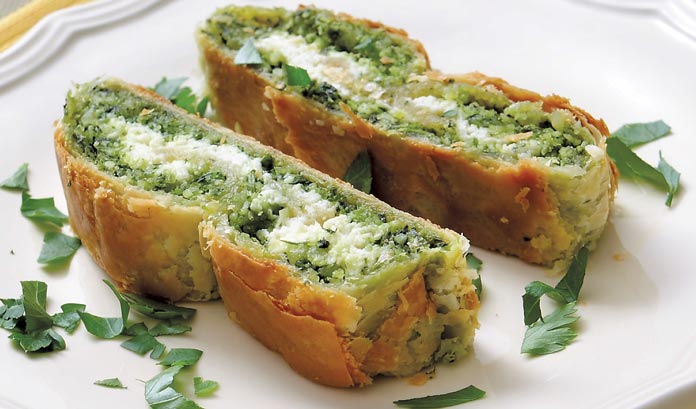 Greek Feta is full of flavor, beautiful in its simplicity and spectacularly luscious. It’s creamy, rich, a little salty and a bit tangy, but not at all sour. All of these flavorful details are ensured by the PDO distinction, which is so very important. It’s a stamp or seal of the highest quality – confirming that an overseeing agency has ensured that the highest levels of production have been met from start to finish, yielding the best Greek Feta.
Greek Feta is full of flavor, beautiful in its simplicity and spectacularly luscious. It’s creamy, rich, a little salty and a bit tangy, but not at all sour. All of these flavorful details are ensured by the PDO distinction, which is so very important. It’s a stamp or seal of the highest quality – confirming that an overseeing agency has ensured that the highest levels of production have been met from start to finish, yielding the best Greek Feta.
Greek Feta is in fact also one of the healthiest cheeses there is. It’s lower in fat and calories and higher in calcium than many other cheeses. It’s also full of B vitamins so it gives you energy and is good for your skin – making it a critical ingredient in any healthy, delicious, well-balanced Mediterranean diet.
According to Dr. Stefanos Kales, a professor at Harvard Medical School and the Harvard TH Chan School of Public Health, “Greek feta is a nutritious food that is highly characteristic of the traditional Greek diet and table. It is a rich and savory source of healthy protein and calcium with probiotic properties that is low in sugars and carbohydrates. It should be enjoyed in moderation due to its sodium and saturated fat content, but these properties also make it an ideal condiment when added to many Greek dishes.”
Where can you find Greek Feta?
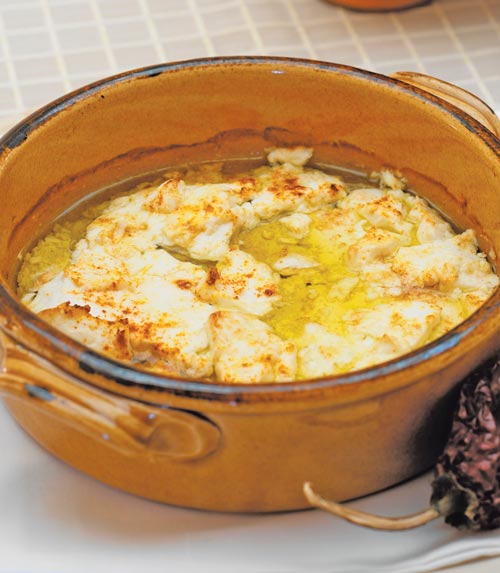 You can find Greek Feta in a variety of high-end grocery stores, from your local cheesemonger and from a number of suppliers these days. You can even order it online!
You can find Greek Feta in a variety of high-end grocery stores, from your local cheesemonger and from a number of suppliers these days. You can even order it online!
Greek Feta should always come in brine and you should keep it in the brine until serving it or it will go bad. True Greek Feta will almost always be sold in block or brick form – not crumbled – because you want the cheese to retain the moisture to experience its full flavor.
It’s the basis of one of the most popular dips in my Loi Food Products line too – Loi Feta-Yogurt Pougi – which is made with Greek yogurt, Feta, olive oil and some herbs and spices (available at MidAtlantic Whole Foods Markets and FreshDirect).
Is Greek Feta better cooked or uncooked?
Feta is clearly having a viral moment right now thanks to the baked Feta recipe circulating on social media. I personally loved Ryan Seacrest’s version. The truth is – it’s scrumptious no matter how you use it. I love Greek Feta for its culinary versatility – it’s a cheese you can really play around with and it’s hard to find a dish it doesn’t work well in.
In Greece, we most often use it uncooked – adding it to Greek salads of course and on top of all sorts of roasted vegetable and seafood dishes. I use it when making Tyropita Triangles – combining it with Anthotyro (the Greek version of ricotta cheese, or really, I should say that ricotta cheese is the Italian version of Anthotyro) to make the crispy, flaky, melt in your mouth mini cheese pies that are so famous in my home country.
It’s also a delightful surprise, like when used in a watermelon salad with some fresh herbs, or wrapped in phyllo dough and drizzled with honey for dessert. With the best of the best Greek Feta – you can also skip the dough entirely and drizzle a bit of honey directly on the cheese for a tasty, healthy, easy food finale.
However you use it – I guarantee this – you will not be disappointed. Kalí órexi! Enjoy your meal!
For more information on PDO Feta, please visit this website.























